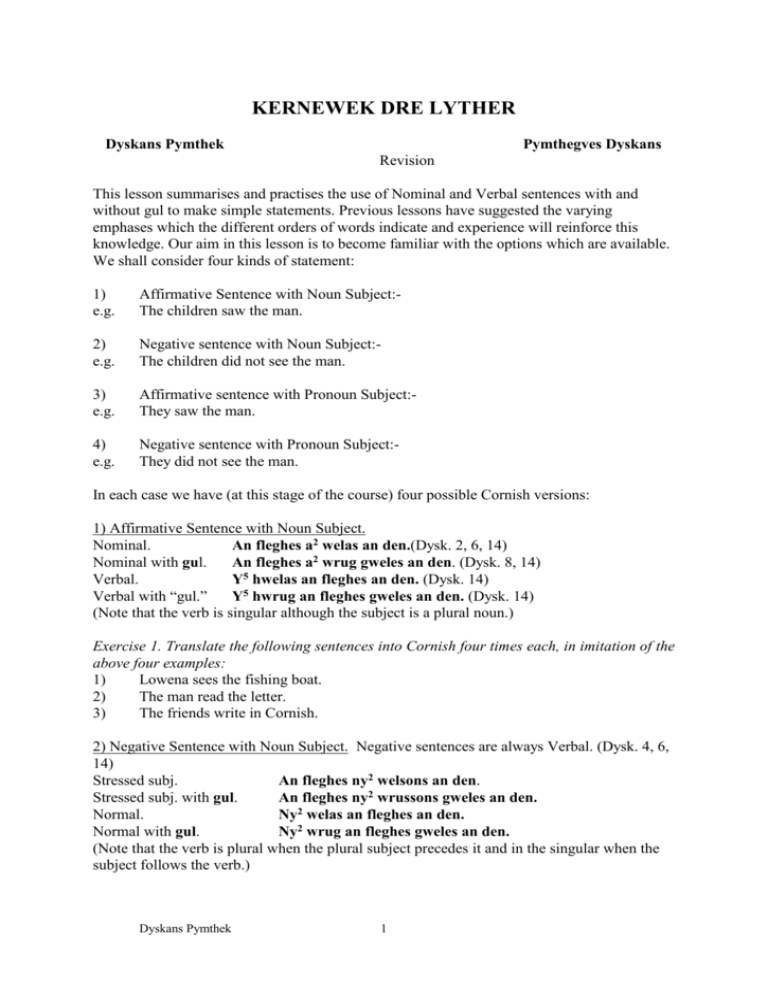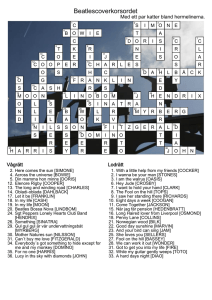kdl15
advertisement

KERNEWEK DRE LYTHER Dyskans Pymthek Pymthegves Dyskans Revision This lesson summarises and practises the use of Nominal and Verbal sentences with and without gul to make simple statements. Previous lessons have suggested the varying emphases which the different orders of words indicate and experience will reinforce this knowledge. Our aim in this lesson is to become familiar with the options which are available. We shall consider four kinds of statement: 1) e.g. Affirmative Sentence with Noun Subject:The children saw the man. 2) e.g. Negative sentence with Noun Subject:The children did not see the man. 3) e.g. Affirmative sentence with Pronoun Subject:They saw the man. 4) e.g. Negative sentence with Pronoun Subject:They did not see the man. In each case we have (at this stage of the course) four possible Cornish versions: 1) Affirmative Sentence with Noun Subject. Nominal. An fleghes a2 welas an den.(Dysk. 2, 6, 14) Nominal with gul. An fleghes a2 wrug gweles an den. (Dysk. 8, 14) Verbal. Y5 hwelas an fleghes an den. (Dysk. 14) Verbal with “gul.” Y5 hwrug an fleghes gweles an den. (Dysk. 14) (Note that the verb is singular although the subject is a plural noun.) Exercise 1. Translate the following sentences into Cornish four times each, in imitation of the above four examples: 1) Lowena sees the fishing boat. 2) The man read the letter. 3) The friends write in Cornish. 2) Negative Sentence with Noun Subject. Negative sentences are always Verbal. (Dysk. 4, 6, 14) Stressed subj. An fleghes ny2 welsons an den. Stressed subj. with gul. An fleghes ny2 wrussons gweles an den. Normal. Ny2 welas an fleghes an den. Normal with gul. Ny2 wrug an fleghes gweles an den. (Note that the verb is plural when the plural subject precedes it and in the singular when the subject follows the verb.) Dyskans Pymthek 1 Exercise 2. Translate the following sentences into Cornish four times each in imitation of the four examples: 1) The woman did not speak with me. 2) Anjela did not see the car. 3) His friends do not work in the book shop. 3) Affirmative Sentence with Pronoun Subject. Nominal. I a2 welas an den. (Dysk 2, 6, 14) Nominal with gul. I a2 wrug gweles an den. (Dysk. 8,14) Verbal. Y5 hwelsons an den. (Dysk. 14) Verbal with gul. Y5 hwrussons gweles an den. (Dysk 14) (Note that the verb remains 3rd. sing. in the Nominal sentences but. agrees with the 3rd. plur. subject in the Verbal sentences.) Exercise 3. Translate the following sentences into Cornish four times each in imitation of the four examples: 1) I saw Yann. 2) She sees Erwan. 3) He sent the letter. 4) Negative Sentence with Pronoun Subject. Again, as these are negative, they are all Verbal sentences. (Dysk. 4, 6, 14) Stressed subject. I ny2 welsons an den. Stressed subject with gul. I ny2 wrussons gweles an den. Normal. Ny2 welsons (welsons i) an den. Normal with gul. Ny2 wrussons (wrussons i) gweles an den. (Note: the verb is plural to agree with the plural subject. The pronoun subject may be suffixed to the verb if it does not precede it.) Exercise 4. Translate the following sentences into Cornish four times each in imitation of the four examples: 1) He does not speak Cornish. 2) She did not send the letter. 3) We did not see the children. Skrif Write an account of a train journey, using as many different verbs in as many ways as you can. You will find nominal sentences with gul the easiest to use but try and use at least one or two other possibilities as well.







